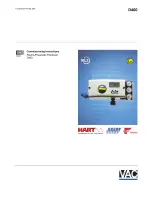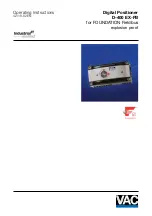
2 Safety
2.3 Mechanical Safety Devices
2-2
162068-1CD
162068-1CD
MH-SERIES
POSITIONER
• In accordance with ANSI/RIA R15.06-1999, section 4.2.5, Sources of
Energy, use lockout/tagout procedures during equipment
maintenance. Refer also to Section 1910.147 (29CFR, Part 1910),
Occupational Safety and Health Standards for General Industry
(OSHA).
2.3
Mechanical Safety Devices
The safe operation of the robot, positioner, auxiliary equipment, and
system is ultimately the user's responsibility. The conditions under which
the equipment will be operated safely should be reviewed by the user. The
user must be aware of the various national codes, ANSI/RIA R15.06-1999
safety standards, and other local codes that may pertain to the installation
and use of industrial equipment. Additional safety measures for personnel
and equipment may be required depending on system installation,
operation, and/or location. The following safety equipment is provided as
standard:
• Safety fences and barriers
• Light curtains and/or safety mats
• Door interlocks
• Emergency stop palm buttons located on operator station, robot
controller, and programming pendant
Check all safety equipment frequently for proper operation. Repair or
replace any non-functioning safety equipment immediately.
2.4
Installation Safety
Safe installation is essential for protection of people and equipment. The
following suggestions are intended to supplement, but not replace,
existing federal, local, and state laws and regulations. Additional safety
measures for personnel and equipment may be required depending on
system installation, operation, and/or location. Installation tips are as
follows:
• Be sure that only qualified personnel familiar with national codes,
local codes, and ANSI/RIA R15.06-1999 safety standards are
permitted to install the equipment.
• Identify the work envelope of each robot with floor markings, signs,
and barriers.
• Position all controllers outside the robot work envelope.
• Whenever possible, install safety fences to protect against
unauthorized entry into the work envelope.
• Eliminate areas where personnel might get trapped between a
moving robot and other equipment (pinch points).
• Provide sufficient room inside the workcell to permit safe teaching
and maintenance procedures.
18/101




































